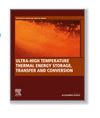Ultrahigh temperature sensible heat storage and heat transfer fluids
Abstract

This chapter addresses the application, selection criteria, and potential of different ultrahigh temperature heat transfer and sensible storage materials and systems. In some cases a single material may be well suited for both heat transfer and storage, while in many applications using different materials/media for storage and heat transfer is better. Herein, the term “ultrahigh temperature sensible heat storage” is defined as the thermal energy associated with a temperature change of above 1000°C, that is, it is purely associated with the increase/decrease in the kinetic energy of atoms in media. The term sensible is used to distinguish it from latent heat, which involves a phase transition, which can occur at a constant temperature because it is associated with breaking and formation of chemical bonds between atoms. Nevertheless, the material/medium could be solids, liquids, and/or gases. Similarly, ultrahigh temperature heat transfer fluids (HTFs) are defined as materials that are used to transfer heat above 1000°C and include solids transported by fluidized, conveyor, or moving beds, liquids, and gases. Because ultrahigh temperature heat transfer systems tend to incorporate a complex set of technical challenges, it is important to build a simplified, approximate, yet complete performance and cost model early on. Many cost factors rely critically on the chemical compatibility of a storage material and other materials it contacts (e.g., pipe walls, tanks, pumps, and seals) because at ultrahigh temperatures, many chemical reactions/transitions are highly accelerated. Thus this chapter focuses first on general materials considerations as the first filter, which rapidly narrows the range of candidate material pairs (medium and containment) that can be used at ultrahigh temperatures. Subsequently, requirements specific to storage versus HTFs are discussed. Finally, heat exchangers are discussed as the bridge between storage and HTFs.
